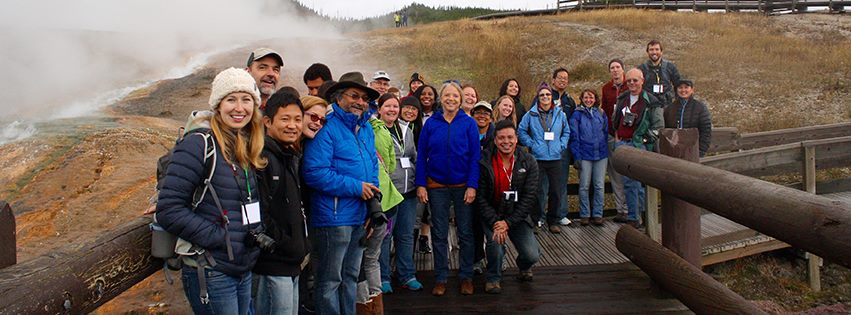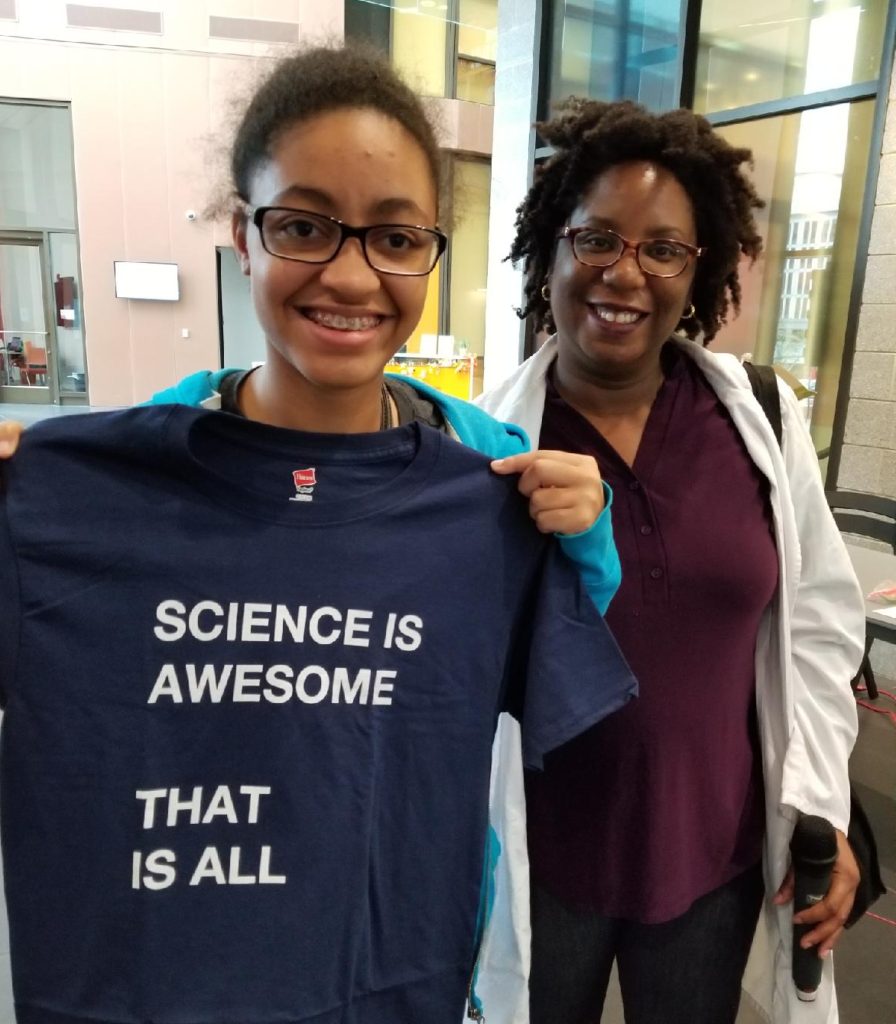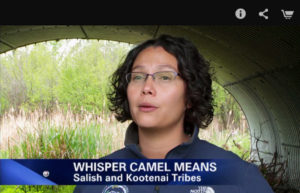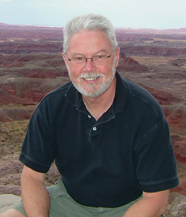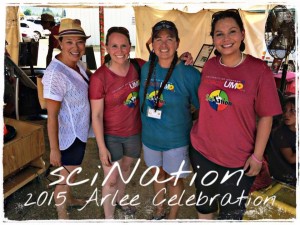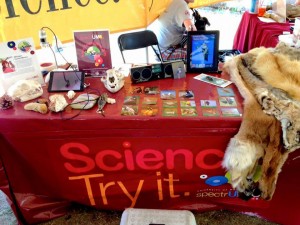The incredible work of the wildlife biologists of the Salish and Kootenai Confederated Tribes has been featured in an HHMI video. We’re glad to see their excellent work getting more attention! Special kudos to COPUS member Whisper Camel-Means for her excellent science communication skills…
Category Archives: News
2018 COPUS Unconference
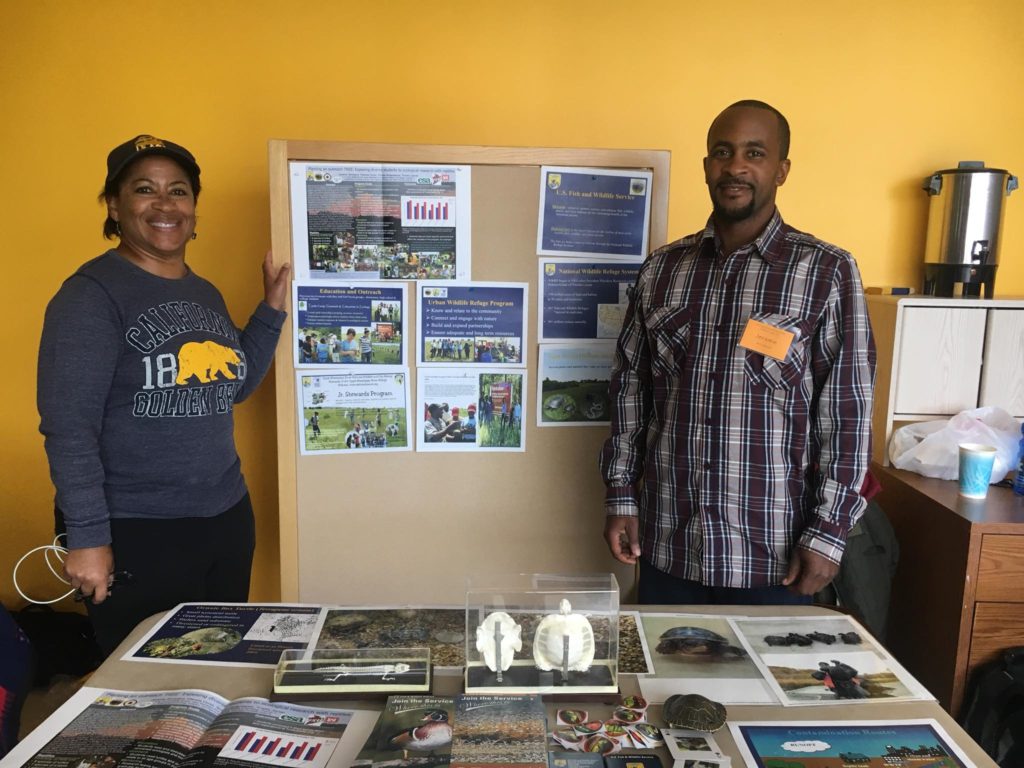
In the Fall of
Jasper Ridge Biological Preserve hosts a community open house – May 12, 2018
PRESS RELEASE FROM STANFORD UNIVERSITY
On Saturday May 12, 2018, from 10 am to 3 pm, Stanford University’s premier terrestrial outdoor research and teaching laboratory in the hills near Palo Alto—Jasper Ridge Biological Preserve—will be open to the public for discovery and exploration in one of California’s most diverse ecological settings. The last time a community open house took place was more than 10 years ago.
Formally established as a biological preserve by Stanford University in 1973 and a part of UNESCO’s Golden Gate Biosphere and the Santa Cruz Mountains Stewardship Network, the preserve is recognized internationally not only for the ecological, geological, and other kinds of research and teaching that have gone on there for more than a century, but also as a gem of nature hidden in the midst of Silicon Valley.
The purpose of this year’s open house is to help the surrounding communities and all who are interested learn about the preserve and the role it plays in Stanford’s mission and in regional and international nature conservation efforts. At this family-friendly event visitors of all ages will have the chance to interact with Stanford researchers and educators conducting work at Jasper Ridge, to take self-guided walks, and to visit exhibits that highlight both current and past research that has made the preserve world-renowned.
Among the special features of the preserve are its diverse vegetation, which include nearly every natural plant community found in west-central California. More than a thousand species of vascular plants, mosses, lichens and fungi have been recorded. Animal communities are no less impressive, with more than 280 vertebrate species (animals with backbones) that range from mountain lions at the largest to shrews at the smallest, plus an untold number of invertebrate animals—snails, worms, insects and so on—that are vital to healthy ecosystems.
This rich assemblage of plants and animals, combined with the remarkably diverse landscape that hosts them, provides an ideal natural laboratory in which to learn how nature works, which over the years has yielded—and continues to yield—important discoveries by researchers from Stanford and around the world. Currently about 60 different research projects are underway each year, some long-term, such as wildlife monitoring through a camera-trapping network that has been in place since 2009 and ant surveys that have been running more than two decades. Other studies play out over shorter time-spans (up to five years), such as determining how microbes affect subsurface soil processes, or how microscopic-size ecosystems evolve deep within sticky monkey-flowers. Educational use abounds, with more than 5000 people learning at the preserve each year, drawn from more than 20 courses at Stanford, from other colleges and high-schools in the area, and from the general public who during the academic year can reserve educational tours via the Jasper Ridge Biological Preserve website: https://jrbp.stanford.edu/visit.
The 1193 acres that now comprise the preserve have a rich historical legacy that will also be featured during the open house. Prior to the arrival of Spanish explorers, Muwekma Ohlone encampments and villages were numerous. After Spanish contact, ranching and timber operations eventually proliferated, and the town of Searsville grew only to be abandoned once Searsville Dam was completed in 1892.
Everyone is welcome to attend the family-friendly Jasper Ridge Biological Preserve Open House. The event is free, but a ticket is required, which can be obtained here: JRBP Open House Ticket. Please note that pets are not allowed and smoking is prohibited throughout the preserve, including outdoors.
Parking will only be available off-site at 2882 Sand Hill Road in Menlo Park, just east of the Sand Hill exit off of 280, about two miles from the preserve. Shuttle buses will run between the parking area and the preserve beginning at 9:30 a.m. Limited ADA parking will be available on-site at the preserve (located at 4001 Sand Hill Road, Woodside) by prior reservation, which can be made here: https://jrbp.stanford.edu/content/contact-us. Bicyclists will be able to park their bikes on-site at the preserve.
Further details about the event, including safety information, what to bring and what not to bring, can be found at: https://jrbp.stanford.edu/content/open-house-information.
A Student’s Perspective: 24 Hours in DC
By Layla Chamberlin
On October 14, 2017, Berkeley’s COPUS intern team participated in SEM Link’s annual STEM Career Fair in Washington DC (click here to see an awesome photo slideshow). The fair was organized for the greater DC community by scientist and educator, Tokiwa Smith. All were welcome at this event, but it particularly highlighted some outstanding local scientists and educators of color. With fun, hands-on activities, it invited students and families to celebrate their love of science, engineering, and math. Impressively, this event was 100% free, open to the public and easily accessible.
I joined the COPUS team this fall, and it’s been my first student internship experience at UC Berkeley. It was only a few weeks into the internship when our team accepted Tokiwa Smith’s invitation to participate in the SEM Link fair. I had never participated in a science fair nor visited DC before, and we were already boarding our plane to fly across the country before I could say “Coalition for the Public Understanding of Science!”
 We left Oakland around 7pm on a Friday, and after one layover, our plane finally landed in DC around 7am the next day — just as the sun began to rise. Being in a new city, far away from the Bay Area, was refreshing after so many routine days and laps around the Berkeley campus. As we crossed the bridge and entered the city, I heard the Jurassic Park theme song play in my head. (Thanks John Williams – that song still gives me chills). As a first-timer to the city, I was mesmerized by the magnificence of the massive colonial architecture on 14th Street and the modesty of the quaint brick homes behind the face of the historical epicenter. Our first stop was at a lovely local restaurant called Ted’s Bulletin where we hydrated, caffeinated and satiated ourselves before we went to the University of the District of Columbia, UDC, to set up for the fair.
We left Oakland around 7pm on a Friday, and after one layover, our plane finally landed in DC around 7am the next day — just as the sun began to rise. Being in a new city, far away from the Bay Area, was refreshing after so many routine days and laps around the Berkeley campus. As we crossed the bridge and entered the city, I heard the Jurassic Park theme song play in my head. (Thanks John Williams – that song still gives me chills). As a first-timer to the city, I was mesmerized by the magnificence of the massive colonial architecture on 14th Street and the modesty of the quaint brick homes behind the face of the historical epicenter. Our first stop was at a lovely local restaurant called Ted’s Bulletin where we hydrated, caffeinated and satiated ourselves before we went to the University of the District of Columbia, UDC, to set up for the fair.
When we arrived at the university, we were warmly welcomed by SEM Link’s founder, Tokiwa Smith. On the way over to DC, my team told me so many wonderful things about Tokiwa — meeting her in person did not fall short of my expectations. Despite me being in an unfamiliar place with a relatively new team, Tokiwa exuded a confidence that was comforting, relaxing and made me feel ready to work our booth. As we began neatly laying out our cellular diagrams, color-in cartoons of organelles, and microscope with slides, I was excited to see the other participating groups enter and set up their tables. There was everything from circuit boards to forensic science!
Around 10am, the students and families started to arrive. Despite the diversity in age, from three years old to juniors in high school, every kid that visited our stand eagerly asked interesting, perceptive and engaging questions. I was humbled to learn that so many of the kids there had already begun to code in their early elementary school classes, and many aspired to be engineers, astrophysicists, and neurosurgeons. It was even more inspiring to see these thirsty young minds working side by side with amazing scientists, engineers and teachers, all of which had given up their Saturday to bring science to the community.
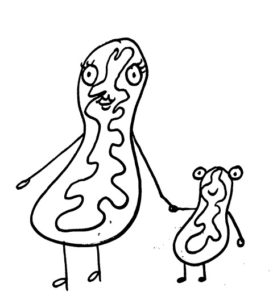 As the fair filled up and kids were racing around, fervently asking questions and dragging their friends to go with them to the various stands, we (the COPUS interns) began honing our skills as educators. I learned that this style of teaching, casual and curiosity-driven, is very effective in facilitating a scientific dialogue with children. In comparison to a classroom exercise, it allows kids to interact with the material on a much more intimate level. Our table didn’t come with a worksheet or a set of instructions, and kids could explore on their own terms.
As the fair filled up and kids were racing around, fervently asking questions and dragging their friends to go with them to the various stands, we (the COPUS interns) began honing our skills as educators. I learned that this style of teaching, casual and curiosity-driven, is very effective in facilitating a scientific dialogue with children. In comparison to a classroom exercise, it allows kids to interact with the material on a much more intimate level. Our table didn’t come with a worksheet or a set of instructions, and kids could explore on their own terms.
One girl, who was a second grader, sat with me for an hour and looked at each of the 25 microscope slides multiple times. Our slides were a slice through biodiversity – showing sections of tissues from mushrooms, plants, insects, and vertebrates. For each slide, I asked her what organism she thought it came from. And for each tissue type she observed, I told her a bit about how it functions in the organism. By the end of my hour with her, she began to make her own hypotheses as to why specialized cells are structured the way they are. Not all my interactions were this long, but no matter the length of time spent with each child, each conversation was just as charming and rewarding. Krystin Ventura, another COPUS intern, said that when she told one girl that the DNA in her mitochondria comes from her mother, the girl looked up at her mom, giggled and said, “That’s really nice of you.”
It was all over too soon and by 3pm we were wrapping up and heading out. By Sunday morning, we were already back in the SF Bay Area; concluding a quick 24-hour trip! But it was an experience I won’t soon forget. It was heartwarming to see both parents and students, and people of all genders and colors become engaged learners and equally share the same curiosity for science. For every child that held on tightly as they peered into our microscope, their parent or guardian also looked through the lens with deep fascination.
That morning, on the way to the science fair, I learned that our 67 year old Lyft driver had never visited any of the Smithsonian museums on the National Mall. (These public museums are completely free to all visitors.) Before retiring, he had worked in a government job located in the heart of the city. He was an African American man that had grown up in Washington DC — lived and worked there his whole life. He’d never visited a national museum, even though his son is currently a security guard at the new National Museum of African American History and Culture. He said it was due to the excessive traffic and tourism in the area. But some of our team wondered – as a child and teen, were his schools welcomed into the museums for tours? Did the museums make an effort to reach out to his neighborhood and welcome his community? As an adult, it’s easy to see why a person would choose to avoid traffic and touristy spots, but with the resources so close by, it’s telling that he’d never had an experience with them as a kid.
 DC has been a city with inspirational African American leaders and strong education institutions for a long time – Howard is a renowned university and has been around since 1867. However, in the early 1900s, President Woodrow Wilson made all federal government agencies segregated – schools, parks, and recreation facilities were segregated back then. This segregation stood until President Franklin Roosevelt was in office, when it began to be dismantled. But much was still segregated in DC all the way into the mid-to-late 1950s. And continued racism and injustices spurred riots in the city in the 1960s. By then, DC had become a city with a majority African American population – however, dating back to the 1870s, the U.S. president had dictated the local leadership. The people couldn’t elect their own city leadership! Thanks to a lot of activism in the community, in the 1970s, DC finally gained the right to elect their own mayor. And ever since, African American leadership has worked to transform the city into what it is today – a beautiful, vibrant metropolis with an awesome array of places to see and go.
DC has been a city with inspirational African American leaders and strong education institutions for a long time – Howard is a renowned university and has been around since 1867. However, in the early 1900s, President Woodrow Wilson made all federal government agencies segregated – schools, parks, and recreation facilities were segregated back then. This segregation stood until President Franklin Roosevelt was in office, when it began to be dismantled. But much was still segregated in DC all the way into the mid-to-late 1950s. And continued racism and injustices spurred riots in the city in the 1960s. By then, DC had become a city with a majority African American population – however, dating back to the 1870s, the U.S. president had dictated the local leadership. The people couldn’t elect their own city leadership! Thanks to a lot of activism in the community, in the 1970s, DC finally gained the right to elect their own mayor. And ever since, African American leadership has worked to transform the city into what it is today – a beautiful, vibrant metropolis with an awesome array of places to see and go.
With all this history in mind, it’s clear that a lot has changed in DC over the last 67 years. A child’s experience in Washington DC in the 1950s or 60s could have been very different from today. But even today, it’s readily apparent that there’s far more work to be done to make sure all people feel welcomed and respected in our public institutions and places of learning.
Seeing all the joy in the room at the science fair, I was struck with the importance of outreach events like the ones SEM Link provides. We can’t assume that just because there’s already museums in a community that all science education needs are being met. It’s ignorant to assume that all those who have curious minds will seek out established institutions for their learning.
This experience brought home to me the importance that we need to start opening doors when people are young, and make sure those doors stay open and welcoming throughout their lives. As we work to reimagine how STEM education can be, and prioritize equity and inclusion in our efforts – ensuring science is truly welcoming and accessible to all – we need to support organizations like SEM Link that are bringing science to the people and letting them know that science is for everyone.
Special thanks to Krystin Ventura for obtaining a grant from UC Berkeley (SOF Program) so that we could make the trip! And also thanks to COPUS and the UC Berkeley URAP Program for providing additional funds for materials and travel. And lastly, a very special thanks to COPUS member Tokiwa Smith, for creating this opportunity in the first place!
One more thing – I want to give a shout out to UDC, which has a fabulous campus! And two cheers for all of our country’s federally recognized HBCUs, or Historically Black Colleges and Universities.
STEM Career Fair in DC: Sweet Success
By Krystin Ventura
COPUS member and Founder & Executive Director of SEM Link (Science, Engineering, and Mathematics Link, Inc.) Tokiwa Smith is an expert in science education and outreach. She’s been organizing SEM Link’s signature STEM Career Fair for over 10 years in Atlanta, Georgia, and is expanding SEM Link’s influence each year. Last weekend, SEM Link held their second annual STEM Career Fair in Washington, DC, where over 100 attendees from the community were able to engage with hands-on science exhibits and meet STEM professionals from a variety of fields.
Tokiwa was motivated to start organizing these career fairs as a way to address the lack of hands-on STEM activities in many communities. She believes that the best way to positively influence the next generation of scientists is to illustrate the diversity of career opportunities in STEM to K-12 students and their parents. She says, “I wanted to create a space for parents to be a part of the STEM Career Exploration process for their children by having an event that they can bring their kids to and engage in hands on STEM activities together.”
In addition, she ensures that students who attend a SEM Link event will be able to interact with a diverse ensemble of exhibitors and presenters. “As an African American woman, I want to make sure that kids that look like me are able to take advantage of these types of opportunities,” she says.
New for this year in DC, Tokiwa graciously invited the COPUS member network to join in and table at the event. Representatives from the SF Bay Area COPUS hub (Monica Albe, Krystin Ventura, Yennie Shyu, and Layla Chamberlin) were excited to participate and had a wonderful time meeting all the kids and their families that day and showing them a little bit about cell biology. They are looking forward to next year already!
In the future, SEM Link is hoping to see STEM career fairs expand to other communities in the nation. Tokiwa is the author of A Guide to Hosting STEM Events, a resource she recommends to anyone interested in coordinating a STEM outreach event.
To help SEM Link connect even more students to STEM career fairs, make a financial contribution to the “Donate Your Lunch Money” Individual Donor Campaign.
“Science is Awesome. That is all.” t-shirt design by COPUS member David Ng.
Wildlife Corridors
NOVA and PBS: Wild Ways
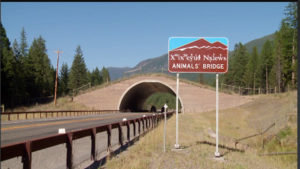
NOVA/PBS featured wildlife biologist Whisper Camel-Means and the Flathead Reservation in a “Wild Ways” look into wildlife corridors and conservation efforts.
Watch for the segment about 30 minutes in to hear more about “one of the most wildlife friendly road projects in the world.”
COPUS is excited to see this project highlighted — we’ve loved it ever since Whisper presented on it at the 2015 Yellowstone COPUS Unconference!
2016 Paul Shin Award
 By Keeley Takimoto
By Keeley Takimoto
COPUS is proud to announce Russell Ledet as the winner of the 2016 Paul Shin Award recognizing “unsung heroes” who have demonstrated commitment and passion in work related to Science, Technology, Engineering and Math (STEM) education/outreach, STEM equity/inclusion, and/or scientific literacy.
Looking at Russell today, you see a seemingly tireless and impeccably competent science professional. A Ph.D. candidate at the New York University (NYU) School of Medicine working long hours in prostate cancer research, he also mentors and serves on the board of directors for Clear Direction, the STEM mentoring organization he co-founded along with Julia Derk. It would be easy to assume he has spent his whole life in the field. But as Russell notes, when it comes to successful scientists, “everybody sees the building, nobody sees the foundation”.
Traditionally, the foundation of a STEM career has been characterized as a “pipeline”: a linear pathway through academia that future scientists enter as kindergarteners and emerge from as fully-fledged post-docs. The reality is much less straightforward, as Russell can attest. He had little access to working scientists or high-level STEM institutions growing up, making it hard to connect his experience to theirs. Without a “clear direction” into science, he instead enlisted in the US Navy after high school. It was there that he got to exercise his love of reasoning and analysis by working in cryptology and computer science, and it was there that he had his breakthrough about working in STEM:
“If [kids] don’t see what it’s like to live in that space, you’re talking to deaf ears.”
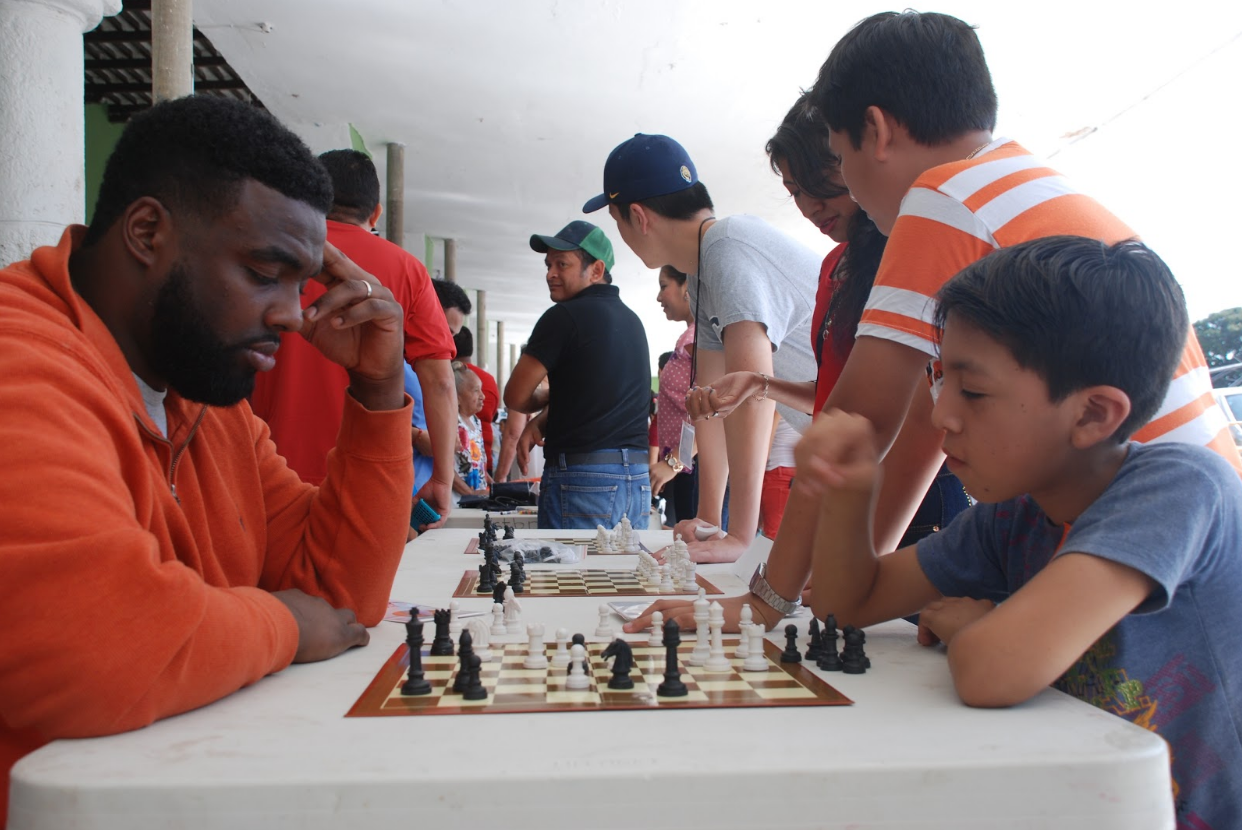 Matching wits with an opponent during the 2017 COPUS Unconference Day of Service in Ixil
Matching wits with an opponent during the 2017 COPUS Unconference Day of Service in Ixil
This idea was at the forefront of his development of Clear Direction Mentoring. Clear Direction works to help young people who, like Russell, don’t see an obvious path into the field. The program pairs PhD and MD/PhD students with high school juniors from underprivileged and underrepresented New York City boroughs with an expressed desire to study STEM. Clear Direction mentees explore diverse aspects of STEM in the real world, from attending lectures from experts on the financial, political, or industry aspects of STEM, to lunchtime discussions and experiments with other mentors and mentees.
The mentorship process seeks to “redefine mentorship” to create a relevant, personalized, and ultimately supportive program for each student. “For anyone to be a mentor,” Russell says, “they’ve got to believe that any kid could end up in their position one day…without [the mentee’s] viewpoint, how is our approach relevant?” Mentors are matched to students based on interest, and the experience can involve everything from hands-on lab work to advice on navigating high school during the two years of formal mentorship. Today, Clear Direction has 30 mentors working to inspire students in over 1,000 mentorship hours to date.
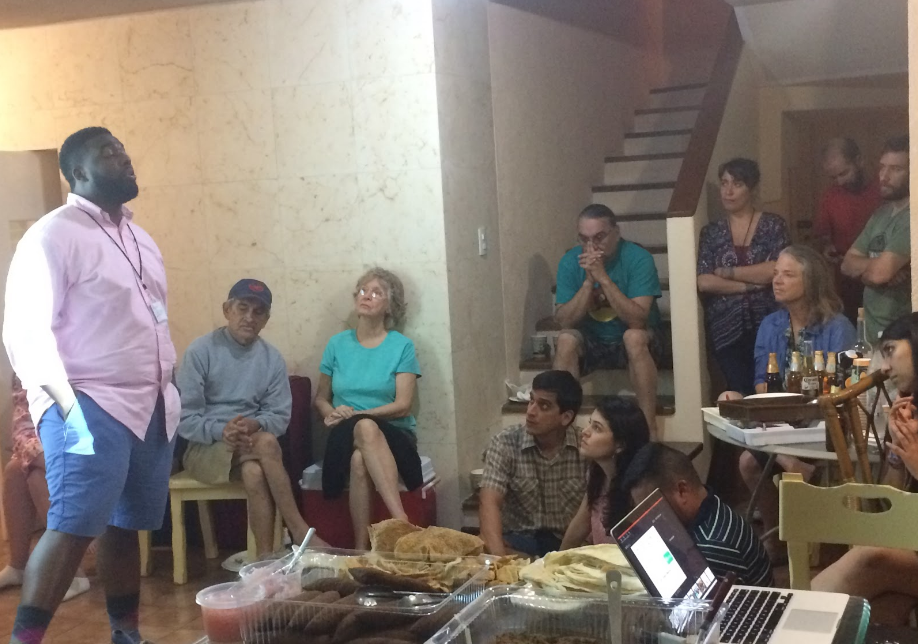 Russell presenting on Clear Direction at the 2017 COPUS Unconference
Russell presenting on Clear Direction at the 2017 COPUS Unconference
COPUS member Lance Powell, who served on the awards committee, states that the group was in complete agreement that Russell should receive the award. “We were impressed with the success he has had in reaching underrepresented high school aged youth in the sciences and matching them with mentors who they work with long term, and then following them to and through college,” says Lance, noting that the work Clear Direction does exemplifies the ideals of COPUS and Paul Shin. “As a result of his work, not only are more kids finding their passion in science, they are finding opportunities through science to improve their lives.”
Congratulations to Russell — COPUS thanks you for your tireless efforts in STEM and STEM outreach!
Ixil Science Fair – first ever!
COPUS Day of Service 2017: Ixil, Yucatán, Mexico
By Krystin Ventura
En español (thanks to Luis Abdala for the translation!)
What does a leaf look like under a microscope? How did an asteroid cause the extinction of the dinosaurs? How do bees make honey? The young science enthusiasts of Ixil, Yucatán can give you the answers!
On January 15, 2017, the Coalition for the Public Understanding of Science (COPUS) collaborated with the local non-profit, Proyecto Itzaes, to hold the very first science fair in the village of Ixil, Yucatán, Mexico. Proyecto Itzaes program coordinators, Jessica Cetz Dzib and Francisco Pech Cutz, were especially instrumental in orchestrating such a successful day. This event tied perfectly into Proyecto Itzaes’ mission to bring educational resources to rural Maya villages on the Yucatán peninsula, and to infuse the thrilling experience of discovery in these communities.
A diverse group of scientists and educators from Mexico, the United States, and Canada prepared interactive booths spanning chemistry, agroecology, mathematics, physics, and beyond, with the goal of inspiring a sense of scientific curiosity (see full list of science booths below). With hundreds of villagers in attendance — the majority of them children — it was a huge success: by the end of the day, several determined young Ixil engineers had even built a twenty-foot roller coaster out of paper towel rolls and masking tape.
Vital to the success of the event was the bidirectional communication of scientific and cultural learning, between scientists and educators, children and adults, and spanning four languages (Maya, Spanish, Salish, and English). Many of the hands-on activities had particular significance to the local economy and culture, thanks in large part to the involvement of scientists and educators from the region. Community members shared their knowledge of local plant species for use in traditional medicines and home remedies. A local beekeeper displayed one of his hives and shared his extensive knowledge of the trade, including the fact that the Melipona bees native to the area don’t sting! A lively dance festival, photography art show, choir performance from the local schoolchildren, and even a comedy act accompanied the science fair. Additionally, COPUS members brought in microscopes, art supplies, and science gadgets that were not only used for the science fair, but found a permanent home with Proyecto Itzaes for future events. Everyone came away with a greater appreciation for something — be it science, local culture, or the delight seen in a small child’s eye when they learn something new.
The idea for the Day of Service originated two years before at the COPUS Yellowstone Unconference. Members agreed that at future unconferences, we’d partner with nearby organizations to give back to the local community. Our first ever Day of Service in Ixil was an excellent start to this new tradition, and so much more than “giving back.” It was an opportunity for COPUS members to come away with new perspectives, fresh ideas, and a personal connection with a very special place. Just as exciting, this event drew in a new audience for Proyecto Itzaes, broadening awareness and support for their incredible work. And one thing we know for sure — the people of Ixil have some remarkable young minds and talented mentors that when given the opportunity, are powerful contributors in our scientific community.
Science Booths:
Mathematics — Proyecto Itzaes volunteer Aldo Escobedo and Jessica Cetz Dzib
Chemistry — Proyecto Itzaes volunteer Emanuel Koyoc
Traditional Medicine – Ixil volunteer Luisa Tec
Robotics — Proyecto Itzaes volunteer Saul and Eric
Agroecology — Proyecto Itzaes volunteer Lucia Cen
Health — Proyecto Itzaes volunteer Edgar Pech and Carmen Cetz
Bees — Proyecto Itzaes volunteer
Chess — Proyecto Itzaes volunteers, and COPUS member Russell Ledet
Roller Coaster Engineering — COPUS members Luis Abdala, Tokiwa Smith, Tom McFadden
Microscopes (dissecting, slide, and foldscopes) — COPUS members Christopher Alvaro, Stu Koretz
Properties of Water — COPUS member Lance Powell and Austin Ayer
Beans of the Yucatán — COPUS members Jorge Carlos Berny Mier y Teran and Kimberly Gibson
Bats of the Yucatán — COPUS member Diana Moreno
Birds of the Yucatán — COPUS member Daniela Tarhuni
Evolution Card Game — COPUS member David Ng
Surface Tension — COPUS members Bill and Ruth Swaney
Asteroid Impacts — COPUS member Lisa White
Perception Shifting Goggles — COPUS members Maya Bialik and Stephanie Sasse
Presentation on mass extinction — COPUS members Rodolfo Dirzo and Guillermina Gomez
Architecture and Art (with kids blocks) — COPUS members Monae Verbeke and Diego Roman
Nest/egg Camouflage Game — COPUS members Monica Albe and Mattias Lanas
En español
Día de Servicio 2017 COPUS: Ixil, Yuctán, México
Autor: Krystin Ventura
¿Cómo se ve una hoja debajo de un microscopio? ¿Cómo un asteroide pudo causar la extinción de los dinosaurios? ¿Cómo hacen miel las abejas? ¡Los jóvenes entusiastas de Ixil, Yucatán te pueden dar las respuestas a estas preguntas!
El 15 de enero de 2017, la Coalición para el Entendimiento Público de la Ciencia (COPUS, por sus siglas en inglés) colaboró con la organización no lucrativa, Proyecto Itzáes, para llevar a cabo la primera feria de la ciencia en la localidad de Ixil, Yucatán, México. Los coordinadores de programas de Proyecto Itzáes, Jessica Cetz Dzib y Francisco Pech Cutz, fueron claves en la organización de este exitoso día. El evento compaginó perfectamente con la misión de Proyecto Itzaes de llevar recursos educativos a pueblos mayas rurales y de inyectar en estas comunidades la emocionante experiencia del descubrimiento.
Un grupo diverso de científicos y educadores de México, Estados Unidos, y Canadá prepararon stands interactivos que incluyeron actividades relacionadas a química, agroecología, matemáticas, física, entre otros, con el fin de inspirar un sentimiento de curiosidad científica (ver abajo lista completa de stands). Acudieron cientos de pobladores de Ixil a la feria, – la mayoría de los cuales fueron niños – por lo que el evento resultó un enorme éxito: al final del día, varios jóvenes (futuros) ingenieros de Ixil terminaron de construir una montaña rusa de seis metros de largo usando masking tape y rollos de carton de papel de baño.
La comunicación bidireccional involucrando el aprendizaje científico y cultural entre científicos, educadores, niños y adultos, utilizando cuatro idiomas (maya, español, salish, e inglés), fue de vital importancia para el éxito del evento. Muchas de las actividades manuales e interactivas tuvieron un significado particular para la economía y cultura local, lo cual en gran medida se debió a la participación de científicos y educadores de la region. Miembros de la comunidad compartieron su conocimiento de las plantas locales usadas en medicina tradicional y para producir remedios caseros. Un productor local de miel desplegó una de sus colmenas y compartió su amplio conocimiento de esta actividad productiva, incluyendo el hecho que ¡las abejas meliponas nativas de la región no poseen aguijón! Un animado festival de baile, una diversa exposición fotográfica, un número por parte de un coro de niños locales de una escuela, e incluso un acto de comedia fueron algunas de las actividades que se sumaron a la feria científica. Adicionalmente, los miembros de COPUS trajeron microscopios, insumos artísticos, y artilugios científicos los cuales fueron utilizados en la feria y fueron donados a Proyecto Itzáes para su utilización en futuros eventos. Todos los participantes adquirieron una mejor apreciación de algún fenómeno, idea o sentimiento relacionado a ciencia o cultura local o bien simplemente la satisfacción de ver en los ojos de un niño el sentimiento positivo de aprender algo nuevo.
La idea del Día de Servicio se originó dos años antes durante la no-conferencia de COPUS en Yellowstone. Los miembros acordaron que en no-conferencias futuras COPUS uniría fuerzas con otras organizaciónes para aportar conocimientos a las comunidades locales. Nuestro primer Día de Servicio en Ixil fue un excelente inicio para esta nueva tradición y fue mucho más que solo “aportar conocimientos” a la gente local. Fue una oportunidad para que los miembros de COPUS desarrollaran nuevas perspectivas, ideas frescas, y una conexión personal con un lugar muy especial. De igual forma, el evento atrajo una nueva audiencia para Proyecto Itzáes, incrementando la conciencia y apoyo en relación al increíble trabajo que esta organización esta realizando en Yucatán. Y una cosa que sabemos es completamente cierta: la comunidad de Ixil posee destacadas jóvenes mentes y talensosos mentores los cuales tienen el potencial de contribuir a la ciencia si se les proporcionan las oportunidades.
Stands científicos:
Matemáticas – Voluntarios de Proyecto Itzáes Aldo Escobedo y Jessica Cetz Dzib
Química — Voluntario de Proyecto Itzáes Emanuel Koyoc
Medicina tradicional – Voluntario de Ixil Luisa Tec
Robotica — Voluntarios de Proyecto Itzáes Saul y Eric
Agroecología — Voluntario de Proyecto Itzáes Lucia Cen
Salud — Voluntarios de Proyecto Itzáes Edgar Pech y Carmen Cetz
Abejas — Voluntario de Proyecto Itzáes
Ajedrés — Voluntarios de Proyecto Itzáes, y miembro de COPUS Russell Ledet
Construcción de montañas rusas – Miembros de COPUS Luis Abdala, Tokiwa Smith, Tom McFadden
Microscopios (disección, muestras) – Miembros de COPUS Christopher Alvaro, Stu Koretz
Propiedades del agua – Miembros de COPUS Lance Powell y Austin Ayer
Frijoles de Yucatán – Miembros de COPUS Jorge Carlos Berny Mier y Teran y Kimberly Gibson
Murciélagos de Yucatán – Miembro de COPUS Diana Moreno
Aves de Yucatán – Miembro de COPUS Daniela Tarhuni
Juego de cartas de evolución – Miembro de COPUS David Ng
Tensión superficial – Miembros de COPUS Bill y Ruth Swaney
Impactos de asteroides – Miembro de COPUS Lisa White
Gogles que afectan la percepción visual – Miembros de COPUS Maya Bialik y Stephanie Sasse
Presentación de extinciones masivas – Miembros de COPUS Rodolfo Dirzo y Guillermina Gómez
Arquitectura y artes (con materiales para niños) – Miembros de COPUS Monae Verbeke y Diego Roman
Juego de camuflaje con nidos y huevos – Miembros de COPUS Monica Albe y Mattias Lanas
Member Spotlight – Tokiwa Smith
 Tokiwa Smith is a Chemical engineer, STEM Educator and social entrepreneur. She is the Founder and Executive Director of Science, Engineering and Mathematics Link Inc also known as SEM Link a nonprofit organization that she founded in 2005 that exposes youth to STEM and STEM Careers that has programs in Atlanta and the DMV (DC, Maryland and Virginia) areas.
Tokiwa Smith is a Chemical engineer, STEM Educator and social entrepreneur. She is the Founder and Executive Director of Science, Engineering and Mathematics Link Inc also known as SEM Link a nonprofit organization that she founded in 2005 that exposes youth to STEM and STEM Careers that has programs in Atlanta and the DMV (DC, Maryland and Virginia) areas.
She is also CEO and Principal Consultant for Kemet Educational Services, a STEM Educational Consulting Firm that she started in 2010 that focuses on ensuring that pre-college, community college and undergraduates students are prepared to pursue STEM careers. Tokiwa recently relocated back Atlanta, Georgia after spending 7 years in the San Francisco Bay Area, where she first connected with COPUS.
She recently attended her third Unconference, this January in the Yucatan Peninsula Mexico, where we were able to connect with her and learn more about her.
Tokiwa is a native of Miami, Florida and is an alumna of Florida Agricultural and Mechanical University (FAMU) a Historically Black College and University (HBCU). She has spent her career working for and developing STEM educational programs for precollege and undergraduate students to provide opportunities for them to be exposed to and be prepared for STEM careers. Through the work of her consulting firm, Kemet Educational Services she is using her background as an engineer and professional experience to bridge the gap between the STEM community and individuals and organizations that want to add STEM to their programming and/or learn how to engage kids in hands on STEM activities by providing them with strategies and tools to do so. Through the work of her nonprofit SEM Link, she is doing one of the things that she loves the most, exposing youth to STEM by engaging them in hands on STEM activities and connecting them with the STEM community.
Tokiwa’s nonprofit SEM Link, is currently in the midst of its “Its All About the Pi” Spring Fundraising Campaign , which ends on April 28th. The funds from this campaign, which individuals can make their tax deductible financial contribution online will support their programs, which include the 10th Annual STEM Career Fair and Exhibition on Saturday, April 15th at Georgia Tech. This event will provide K-12 students and their families with an opportunity to explore careers and meet and interact with professionals in these fields. In addition, Saturday, April 8th, Tokiwa will go back to her alma mater FAMU and along with SEM Link volunteers engage middle and high school students in a hands on chemistry activity at the STEM Expo on STEM Day hosted by the College of Science and Technology.
Some things she’d like to talk to other COPUS members about:
SEM Link
KEMET
Cooperation
All About the Pi
One of Tokiwa’s memorable Unconference moments:
One of Tokiwa’s most memorable moments from the unconference were from our outreach event. “This is the first time that we incorporated an outreach component to the Unconference. It was great to see us work together as a COPUS core as well as connect with the local STEM community to have a great STEM event for the kids. I met some great future STEM professionals from the Yucatan Peninsula that day, including a little boy named Omar that already knew that he wants to be a civil engineer when he grows up.”
By James Zhou
A Big Thank You

COPUS gives a big, heartfelt thank you to the lovely town of Ixil, our awesome collaborators at Proyecto Itzaes, and all our supporters for making the Science Fair in Ixil, Mexico possible! We’ll be sharing more stories about that and our Yucatán unconference soon….
Support Scientific Empowerment!
Donate here to help us reach our goal: $10,000 for the Mexico Unconference and Science Fair.
As of January 11th, we’ve raised $5,050. Thanks to all of you who’ve donated so far! Let’s keep it going — it’s not too late to give a gift!
Your donation allows us to connect science educators and activists from around the United States with science super stars and students in the Maya community of the Yucatán Peninsula of Mexico. Donations of any amount are greatly appreciated — and check out our awesome rewards:
- $50 = after the January unconference, receive a thank you card with a group photo of us all in Mexico.
- $100 = after Mexico, receive a thank you card and a drawing from one of the students from the science outreach event.
- $250 = after Mexico, thank you card, and a penpal opportunity with a Proyecto Itzaes budding scientist.
- $500 = COPUS will give you or your organization/company a shout-out on our website and social media (with links to your site and their logo). Link and logo will stay on our website for one year from posting date.
- $1000 = Cindy Wilber will give you a personal tour of ‘Hidden Yucatan.’ Airfare not included, but housing (right near beach) and food and a tour guide is!
Email us if you’d also like to donate school/science materials for the Maya community.
We’ll be posting updates about our fundraising goals each week, so check back here and please share with your friends!
COPUS is a completely not-for-profit, volunteer network of individuals and organizations across the nation focusing on scientific literacy, STEM (science, technology, engineering and math) education, and STEM equity/inclusion. Funds are used for fostering community and collaborations in STEM education (such as our unconferences) or providing educational materials to communities in need. Donations are collected through our University of California at Berkeley hub and are 100% tax deductible.
A huge thank you to Tom McFadden of SciencewithTom for creating our beautiful crowdfunding video. And special thanks to Tokiwa Smith of SEMLink, Edward Samaniego of ES Visual Studies, Diego Román, and all other COPUS contributors for the awesome pictures and videos used.
Gearing Up for the 2017 Unconference…
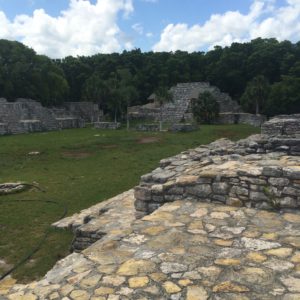 Where’s our next unconference? The Yucatan Peninsula in Mexico!
Where’s our next unconference? The Yucatan Peninsula in Mexico!
This unconference is going to be incredible, and styled a little different from the last one. The new style will allow all attendees to really get to know each other and bond not only over activities and presentations, but through shared experiences and interactions with the local community.
It is a casual, warm, intimate experience for around 25-30 people to share their expertise, best practices, ideas for innovations — and hopefully inspire cross-disciplinary/cultural/regional collaborations. As our mission states, “COPUS is a diverse trans-disciplinary network of individuals and organizations dedicated to public engagement with science. Members represent a wide range of stakeholders and constituencies who work together to articulate a shared vision and accelerate our collective impact.”
This gathering is several things:
- A celebration of STEM education/outreach and the individuals that work tirelessly to promote it.
- An opportunity for the COPUS members to share and learn from the local scientists, educators, and community members through an interactive STEM fair event. Our goal is to empower the local community with science and science connections — but to learn from their expertise and gain understanding from their experiences and perspectives too!
- An opportunity for professional development and networking.
- An opportunity for us all to share with each other and recharge for the year – bringing home cool new ideas and possible connections/ideas for grants, etc.
We will be in the town of Chicxulub Puerto about 35 km from the north side of Merida and about 45 minutes from the airport. For this unconference, we’re partnering with Proyecto Itzaes to connect in with the local community of teachers, scientists, and families.
Tentative Schedule (subject to change):
Note: through out the unconference, we will be focusing on providing professional development and networking opportunities for all attendees.
- Friday, Jan 13th: arrivals and evening networking social
(for those that are here for the full day, we’ll hold a strategic meeting, review our 2016 COPUS events/activities, prepare for Day of Service) - Saturday, Jan 14th:
1) sharing of expertise & member activities from 2016
2) finding points of overlap (grants and collaborations)
3) working group formation for 2017
4) award ceremony & presentations (Paul Shin & Judy Scotchmoor Awards) - Sunday, Jan 15th: Day of Service
interacting with local scientists and teachers, science fair with the Maya community - Monday, Jan 16th: Meeting wrap-up, departures
for those that are here for the full day, we’ll have a “Day of Action” —
1) data sharing for projects
2) make headway on working group action items
3) reporting on Day of Service for website/social media & grants
Remembering Lee Allison
Regretfully I can’t remember how we actually first met. It seems that he was just always there. Lee had an impressive geology career and was serving as the State Geologist and Director of the Kansas Geological Survey during the critical years of cyclic episodes of creationism that overtook the Kansas science standards. So most certainly our paths crossed at the National Conference on the Teaching of Evolution in 2000 if not before.
But in 2005, Lee Allison walked into my office at UC Berkeley, sat down, and said “Judy, we’ve got to do something about these anti-evolution guys – they are anti science!” That was all it took to trigger the idea and then the actions that gave birth to COPUS. That’s who Lee was. He had an unmatched and undeterred energy and enthusiasm about him. Plus, he had an overwhelming passion for understanding the history of our earth and a deep-lying respect for the science that could provide the answers and stimulate more questions.
It seemed that with every encounter with everyone, Lee sparked creative and expanded thinking. That was as true late in his career as it was at our Berkeley meeting in 2005. So before I knew it, we had secured funding from NSF to bring in some folks for brainstorming a national initiative with three goals:
- developing a shared appreciation of science, its contributions to the quality of life, and its underlying role in advances in technology and engineering
- informing and engaging the public in and about science, its process and products
- making science more accessible to everyone
And we even came up with a name – the Coalition on the Public Understanding of Science – COPUS.
Soon there was a COPUS Core of people sharing ideas of concrete steps toward those lofty goals. This resulted in the Year of Science 2009 and the crazy idea of holding an unconference and Lee found the perfect venue – the Biosphere. There in the Arizona desert, the COPUS Core expanded into the COPUS Corps and an annual unconference became the norm… all because of a guy with an impish grin, a huge heart, and an amazing energy.
It was always fun and comfortable being around Lee – whether at a meeting of the minds in DC or sharing a beer at GSA or hanging out with COPUS friends at an unconference. You just wanted to be around him. He will be sorely missed.
By Judy Scotchmoor
2015 Paul Shin Award Winners!
Paul Shin Memorial Award
In the spirit of the energy, passion for science, and generosity of the late Paul Shin, this award was given to wildlife biologists and educators Stephanie Gillin and Whisper Camel-Means from the Confederated Salish and Kootenai Tribes and to University of Montana STEM Education Program Manager, Jessie Herbert at the Yellowstone Unconference in October, 2015.
As a result of a remarkable collaboration towards spreading the excitement of science, Jessie, Whisper, and Stephanie were honored for their work. These powerful women represent both the University of Montana’s spectrUM Discovery Museum as well as SciNation from the Flat Head Reservation. They worked in conjunction to inspire youth living in rural communities with science. Their efforts culminated into the creation of the Science Learning Tent that was showcased at the 116th Arlee Celebration Powwow, which by all accounts, was a complete success. At this tent, over 300 kids got an up close and personal, hands-on science experience. The festival ran for three days and for each day, the tent highlighted a new aspect of STEM. The parents of these kids were amazed at the quality of what was offered. In addition, they also ran programs for kids through Science Bytes, which creates STEM opportunities for kids at free lunch sites. Jessie, the STEM education program manager for UM spectrUM, coordinates the traveling science pop up show continues to expose kids to science as it makes its way around the state. Their intent is to continually make it new as it travels. Based on the success of the Arlee Powwow, we can only imagine that it will make it’s way back to the reservation for the 2nd Annual Science Tent next year.
Paul Shin’s philosophy embodies these two pillars…
“Imagination is more important than knowledge!”-Einstein
“Knowledge is not power – it’s what you do with knowledge-now that’s power!” -Shin
2015 Judy Scotchmoor Award Winner
Judy Scotchmoor Award
In honor of Judy Scotchmoor, a powerful, yet subtle leader who has effectively catalyzed change in the scientific community, this new award went to John Esterle, who embodies the COPUS founder’s interest in promoting science and carrying out the COPUS mission through decentralized channels.
John Esterle works as an executive director of the Whitman Institute. He has enthusiastically supported COPUS for years and believes in “dialogue, relationship building, and inclusive leadership”, which also parallels Judy’s leadership style. John has inspired ideas and invested in people across diverse sectors in an effort to create change. He is the ideal winner for this special award. As part of his recognition, John received an original painting of a sea star by Mattias Lanas — the same beautiful painting depicted in the COPUS logo!
2012 Paul Shin Award
Washington DC — The Coalition for the Public Understanding of Science today announced this year’s winner of the Paul Shin Award – an annual award honoring individuals for their dedication to communicating science to the public.
The 2012 winner is William (Bill) Gomez, Docent at Fitzgerald Marine Preserve and Stanford University’s Jasper Ridge Biological Preserve. Bill was an executive with Syntex for many years and was fortunate to retire early at which point he turned his prodigious talents to teaching and volunteering with various ecology and environmental science groups in the greater San Francisco Bay Area. As a volunteer, his activities vary from speaking to a wide range of visitors about the ecology and biodiversity of the preserves, assisting with research projects, tidepooling for 3rd graders, scuba diving with marine biology students, to sharing science with students at a nearby alternative high school.
Cindy Wilber, Education Coordinator at Jasper Ridge Biological Preserve, nominated Mr. Gomez saying, “Bill’s extraordinary work teaching science to the public in both formal and informal ways has contributed much to the public understanding of science and inspired thousands of learners.” Stuart Koretz, a fellow docent at the preserve wrote, “His respect and love for the natural world, detailed knowledge of natural history, enthusiastic teaching style, modesty and openness make him one of the great unsung heroes: he works tirelessly, without compensation, out of a strong need to reach out and teach natural science.”
Upon receiving the award, Mr. Gomez simply said, “I am deeply honored and overwhelmed.” Mr. Gomez will attend the COPUS 2012 Invitational UnConference in March to receive a $500 cash prize and recognition plaque.
Co-founder of COPUS, Judy Scotchmoor of the University of California Museum of Paleontology said, “The Paul Shin award is very special to us at COPUS. In the short time that we knew Paul, we were captivated by his energy and determination to make a difference in the world. Bill Gomez has a similar dedication and passion for the public understanding of science and is a most worthy recipient of this award.”
